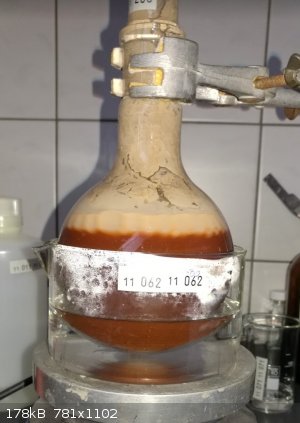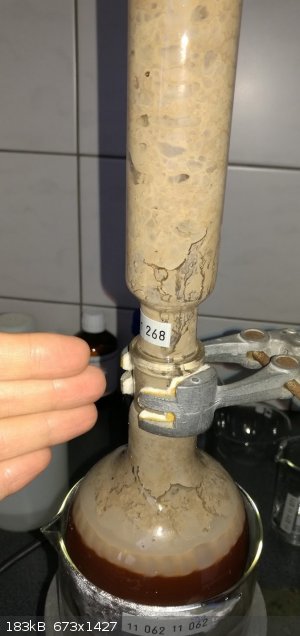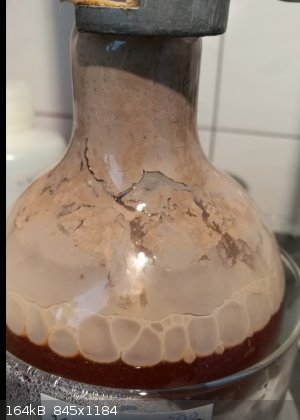stoichiometric_steve
National Hazard
   
Posts: 819
Registered: 14-12-2005
Member Is Offline
Mood: satyric
|
|
PdCl2 preparation with HCl/H2O2: weird precipitate
According to this procedure Recovery of Palladium from Spent Activated Carbon-Supported Palladium Catalysts, i dissolved approx. 4g Pd powder in a mixture of 35g 30% HCl and
40g 30% H2O2 diluted to approx 250ml.
Suddenly, some wild precipitate/crud rising from the mixture appeared, apparently carried along by the Oxygen released from decomposition of H2O2!
Does anybody have an idea what this might be? It's quite a lot, obviously. The yellowish-brown colour hints towards hydrated Palladium oxide, but that
should be soluble in acids, and there's a LOT of acid around.
  
[Edited on 11-8-2016 by stoichiometric_steve]
[Edited on 11-8-2016 by stoichiometric_steve]
|
|
|
Melgar
Anti-Spam Agent
    
Posts: 2004
Registered: 23-2-2010
Location: Connecticut
Member Is Offline
Mood: Estrified
|
|
By process of elimination, it'd seem the likely culprit is something left on the catalyst from a previous reaction; it could be either catalytically
decomposing the peroxide or catalytically oxidizing the carbon, maybe? It could also be oxidizing the HCl to Cl2 and H2O, in which case you might not
have as much acid in the system as you think you do? You wouldn't necessarily be able to smell the Cl2, as it might be reacting immediately. The
last one, I have personally witnessed happen in the presence of strong oxidizers or oxidation catalysts.
|
|
|
solo
International Hazard
    
Posts: 3967
Registered: 9-12-2002
Location: Estados Unidos de La Republica Mexicana
Member Is Offline
Mood: ....getting old and drowning in a sea of knowledge
|
|
......this may not be the answer , but a method is discussed and solution by Bright Star is at hand......solo
https://the-hive.archive.erowid.org/forum/showflat.pl?Number...
It's better to die on your feet, than live on your knees....Emiliano Zapata.
|
|
|
stoichiometric_steve
National Hazard
   
Posts: 819
Registered: 14-12-2005
Member Is Offline
Mood: satyric
|
|
Quote: Originally posted by Melgar  | | By process of elimination, it'd seem the likely culprit is something left on the catalyst from a previous reaction |
I used neat palladium powder, never used before in any reaction, not a supported Palladium catalyst.
Apparently the Hydrogen Peroxide oxidizes PdCl2 to hydrated (and insoluble) PdO. As such, this method seems impractical and highly undesirable.
Well, at least i tried, huh? 
|
|
|
Fleaker
International Hazard
    
Posts: 1252
Registered: 19-6-2005
Member Is Offline
Mood: nucleophilic
|
|
I put Pd into solution w/ 35% peroxide and 10 M HCl literally every day. It works fine. Chlorate works better, HBr and Br2, the best as PdO dissolves
into that milieu.
You have to boil the solution to disproportionate Pd(IV) to Pd(II) and Cl2 gas. Then you can filter off your PdCl2 on a Whatman 541; the filtrate will
carry a couple hundred ppm of Pd, so scavenge with DMG
If I had to guess, I would say way too much peroxide, not enough HCl. You have to evaporate off all of the HCl anyway to get a PdCl2 in water solution
before you can collect it, otherwise it's [PdCl4]2-
Lou
[Edited on 15-8-2016 by Fleaker]
Neither flask nor beaker.
"Kid, you don't even know just what you don't know. "
--The Dark Lord Sauron
|
|
|
stoichiometric_steve
National Hazard
   
Posts: 819
Registered: 14-12-2005
Member Is Offline
Mood: satyric
|
|
Boiling it didn't do much except release more O2 from H2O2 and forming more PdO.
So mixing neat H2O2, HCl and heating the mix will do the job or what is your exact procedure? I didn't think it would be that hard to do.
I have a 0,1M solution of Potassium Bromate and 48% HBr, what proportions would you use?
[Edited on 16-8-2016 by stoichiometric_steve]
|
|
|
AJKOER
Radically Dubious
    
Posts: 3026
Registered: 7-5-2011
Member Is Offline
Mood: No Mood
|
|
If the precipitate can be described as yellow brown, you may have made a PdO2 hydrate. Test by carefully heating a small amount of the dried salt
during which it should liberate water vapor and O2. It also may violently eject itself from the heating vessel. Source: Hand-book of Chemistry, Volume
6, by Leopold Gmelin, page 345, link: https://books.google.com/books?id=pg8AAAAAQAAJ&pg=PA345&... . This last property is distinct from Palladous Oxide, PdO (see comments at http://palladium.atomistry.com/palladous_oxide.html ).
Another test is to treat it with H2, and observe the significant heat evolution accompanied with incandescent. Per Atomistry.com on PdO2 to quote:
"It is reduced by hydrogen at the ordinary temperature, evolving so much heat in the process that the mass becomes incandescent."
Link: http://palladium.atomistry.com/hydrated_palladium_dioxide.ht...
Logic: HCl + H2O2 appears to produce chlorine water in a complex cycling reaction (see http://www.sciencemadness.org/talk/viewthread.php?tid=7622#p... ).
The latter contains HOCl. The action of HOCl on an aqueous Lead salts forms PbO2 and a parallel reaction may occur here (see my comments at: http://www.sciencemadness.org/talk/viewthread.php?tid=62249#... ).
In the case of PdO2 per Atomistry again, one cited path is:
"Mailfert prepared palladium dioxide free from alkali by the action of ozone in the cold on palladous chloride in dilute alkaline solution. The
product, however, contained traces of basic salt. The reaction probably takes place according to the following equation:
Na2PdCl4 + 2NaOH + O3 + H2O = 4NaCl + O2 + PdO2.2H2O "
where the NaOH forms a soluble palladous salt (in possible place of employing Cl2 which acts on PdCl2 creating PdCl3, see http://palladium.atomistry.com/palladium_trichloride.html ) that is oxidized by ozone (or HOCl?).
Of course, you could have a less exciting oxychloride.
[Edited on 21-8-2016 by AJKOER]
|
|
|
Fleaker
International Hazard
    
Posts: 1252
Registered: 19-6-2005
Member Is Offline
Mood: nucleophilic
|
|
Never put the H2O2 into the HCl at the same time--it can passivate end up with you getting a mix of PdO and PdO2 like AJKOER mentioned, it is PdO/PdO2
mixture. Oxidant always to the HCl.
As for remediating your situation...
Two options, after you do as you were told and decompose the gross excess of peroxide...
(1) dissolve some borohydride in 10% caustic, and reduce it all to elemental Pd and start over again after rinsing it free of B and Na.
When I make it, I make it by dissolving the Pd sponge as follows:
Into a 20L flask set up for overhead stirring and heat is charged 1000 grams of dry palladium sponge from sodium formate is slurried in 6 L of 10 M
HCl set up for reflux. The solution is brought to 50-60*C and chlorine gas is sparged into the mixture which goes from a metallic gray slurry to a
light yellow to a dark red to a dark black solution. The reaction is complete when all of the palladium metal has been converted to chloropalladic
acid, H2PdCl6 and no black palladium remains on the bottom (time depends on particle size of sponge; freshly precipitated/reduced is best).
The reflux condenser is removed and the system set up for distillation. The Pd liquor, containing some 5-6 ounces troy per liter is then boiled to
free the solution of dissolved chlorine and disproportionate [PdCl6]2- to [PdCl4]2- and a mol of Cl2. The solution is then freed of excess acid by
further evaporation and concentration whereupon a thick, dense precipitate of PdCl2 may be seen. This is then filtered and washed with ice cold
distilled water and set in a porcelain pan to dry over c. sulfuric acid. Done correctly, the supernate liquid is a slight light yellow and assays
between 300-400 ppm Pd(II) which is recovered by neutralization with caustic alkali to produce the hydroxide, which can be added back into a formate
reduction.
2. Try using HBr to dissolve it. You need not add any oxidant and I'd avoid the use of KBrO3 if at all possible. K salts usually precipitate out as
K2PdBr4 or, with all that halogen, K2PdBr6.
[Edited on 22-8-2016 by Fleaker]
Neither flask nor beaker.
"Kid, you don't even know just what you don't know. "
--The Dark Lord Sauron
|
|
|
stoichiometric_steve
National Hazard
   
Posts: 819
Registered: 14-12-2005
Member Is Offline
Mood: satyric
|
|
Quote: Originally posted by Fleaker  |
(1) dissolve some borohydride in 10% caustic, and reduce it all to elemental Pd and start over again after rinsing it free of B and Na.
|
i was left under the impression that PdO/PdO2 will not dissolve in anything much, so how can it be reduced in alkaline borohydride?
just trying to avoid more mistakes here...
|
|
|
Fleaker
International Hazard
    
Posts: 1252
Registered: 19-6-2005
Member Is Offline
Mood: nucleophilic
|
|
It reduces it to metal under a pH of 11.
Neither flask nor beaker.
"Kid, you don't even know just what you don't know. "
--The Dark Lord Sauron
|
|
|
stoichiometric_steve
National Hazard
   
Posts: 819
Registered: 14-12-2005
Member Is Offline
Mood: satyric
|
|
"Under" implies to me a pH value lower than 11, 10% NaOH has a pH value quite a bit higher than that. Please clarify your statement.
|
|
|
Fleaker
International Hazard
    
Posts: 1252
Registered: 19-6-2005
Member Is Offline
Mood: nucleophilic
|
|
It's in HCl isn't it? So, when you add borohydride to it, it will instantly reduce the oxide to palladium.
That is, slurry it in dilute HCl and add borohydride until a pH of 11.
Neither flask nor beaker.
"Kid, you don't even know just what you don't know. "
--The Dark Lord Sauron
|
|
|
stoichiometric_steve
National Hazard
   
Posts: 819
Registered: 14-12-2005
Member Is Offline
Mood: satyric
|
|
Quote: Originally posted by Fleaker  | It's in HCl isn't it? So, when you add borohydride to it, it will instantly reduce the oxide to palladium.
That is, slurry it in dilute HCl and add borohydride until a pH of 11.
|
thank you, that did clear it up very much. the oxide is indeed slurried in HCl, not so dilute i guess. isn't it a good idea to neutralize to pH 5 with
NaOH first to avoid wasting too much hydride?
|
|
|
Fleaker
International Hazard
    
Posts: 1252
Registered: 19-6-2005
Member Is Offline
Mood: nucleophilic
|
|
It actually works best at pH 2-3 although in basic conditions it works with Pd, and to lesser extent Pt. Rh only works well in pH 1-4 regime or in the
presence of Pd/Pt (w/ BH4- at least).
Have been very busy at work.
You can look at Georg Brauer for another preparation of PdCl2.
Neither flask nor beaker.
"Kid, you don't even know just what you don't know. "
--The Dark Lord Sauron
|
|
|
stoichiometric_steve
National Hazard
   
Posts: 819
Registered: 14-12-2005
Member Is Offline
Mood: satyric
|
|
Thanks, i looked up the preparation by bubbling Cl2 into Pd in HCl. Have you got a good method of safely producing Chlorine? I don't have a fume hood
at this time and could only work outside to do this.
|
|
|
Fleaker
International Hazard
    
Posts: 1252
Registered: 19-6-2005
Member Is Offline
Mood: nucleophilic
|
|
Prepublications here should have good advice.
I haven't prepared chlorine in years--I can simply buy a cylinder at this point.
Regards,
Neither flask nor beaker.
"Kid, you don't even know just what you don't know. "
--The Dark Lord Sauron
|
|
|